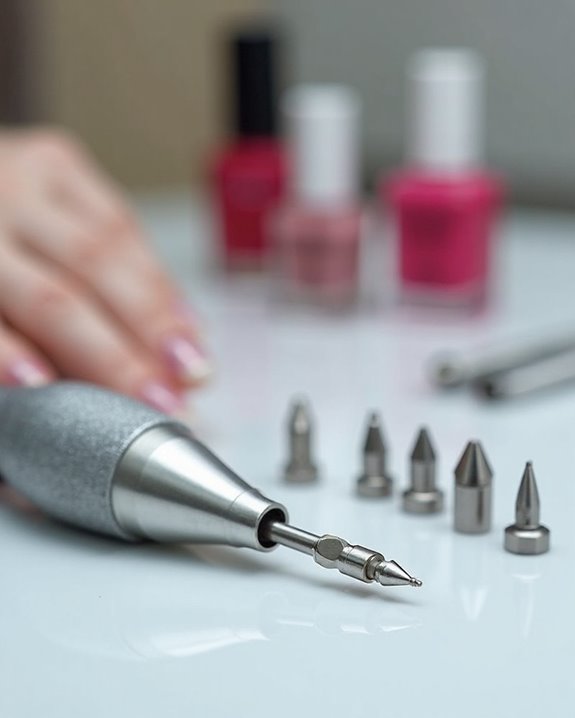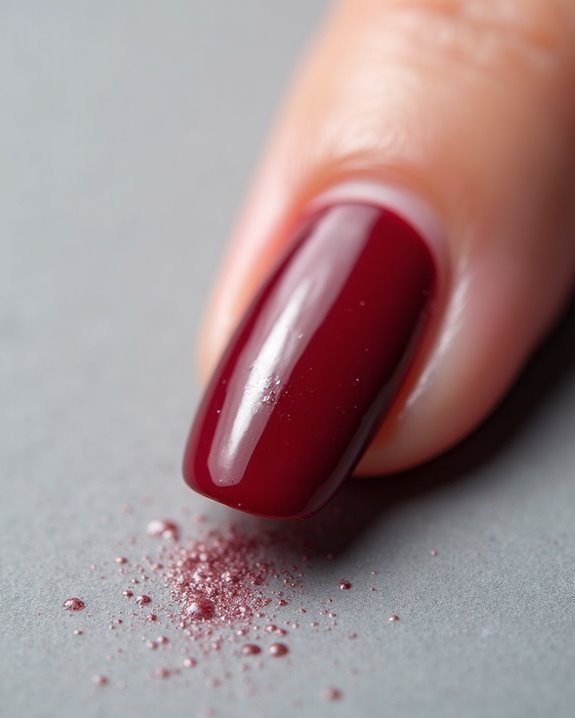Nail drills are professional electric tools that streamline manicure and pedicure services through motorized handpieces with interchangeable bits. They operate at 15,000-25,000 RPM to efficiently remove acrylic or gel products, shape natural nails, smooth calluses, and clean cuticles and sidewalls. Various bit types, including carbide, ceramic, and diamond, perform specialized functions without damaging nail beds or surrounding tissue. Proper bit selection, RPM settings, and sanitization protocols guarantee safe, effective nail services with reduced technician fatigue.
Key Takeaways
- Nail drills efficiently remove acrylic or gel products from nails at 25,000+ RPM, significantly reducing service time compared to manual methods.
- Different bits perform specialized functions: carbide bits remove bulk material, ceramic bits reduce heat, and diamond bits polish surfaces.
- Cone and ball-shaped bits gently clean cuticles and sidewalls without damaging the nail plate or surrounding tissue.
- Barrel bits shape natural nails with side-to-side movements and refine surface irregularities before polish application.
- For pedicures, specialized bits like ceramic barrel bits effectively buff calluses and smooth rough areas on feet.
Understanding Nail Drill Basics and Their Evolution
How did the humble nail file evolve into today’s sophisticated electric nail drill systems? Nail drills, also known as electric files or e-files, transformed from basic manual tools into precision instruments featuring handpieces, motors, and interchangeable nail drill bits. These professional nail tools now operate at specific rotations per minute—typically 15,000 RPM for natural nails and up to 25,000 RPM for acrylics—highlighting their technological advancement.
Modern nail drills incorporate different materials of nail drill bits, including carbide bits, ceramic bits, and diamond-coated options, each serving specialized uses of nail drill techniques. The bits come in different shapes and uses, addressing various manicure and pedicure requirements. This evolution has produced lightweight, low-vibration designs that reduce technician fatigue while enhancing precision, making e-files indispensable for contemporary nail professionals seeking efficiency without sacrificing quality. Furthermore, recent innovations include brushless motors that provide speeds up to 45,000 RPM with minimal noise and vibration for enhanced performance.
Essential Components of Professional E-file Systems
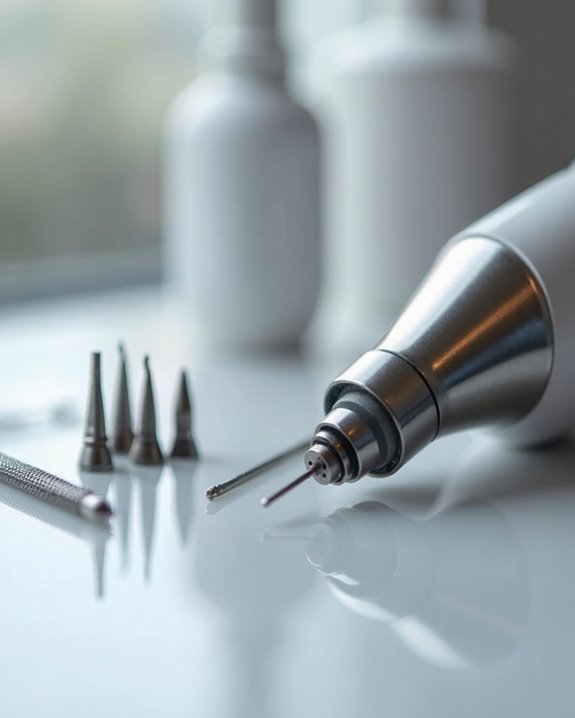
A professional nail drill system consists of several interconnected components that work in harmony to deliver precision and control during nail services. The handpiece serves as the technician’s primary tool, holding various nail drill attachments including carbide bits, ceramic bits, and mandrel bits that secure black nail sanding bands. Electric files feature powerful motors capable of variable speeds, typically ranging from 15,000 RPM for natural nails to 25,000+ RPM for acrylic removal, with high torque maintaining consistent performance under pressure. The bit collection is particularly essential, with large barrel carbide bits efficiently removing bulk material, flame carbide bits accessing difficult cuticle areas, and ceramic nail drill bits generating less heat during extended use. These components, when combined with low-vibration technology, allow professionals to perform detailed nail services while minimizing technician fatigue. For home manicures, comprehensive sets such as the Chumia 47 Pcs offer a variety of bits for reshaping and polishing nails effectively.
Top Nail Drill Bit Types for Acrylic and Gel Removal
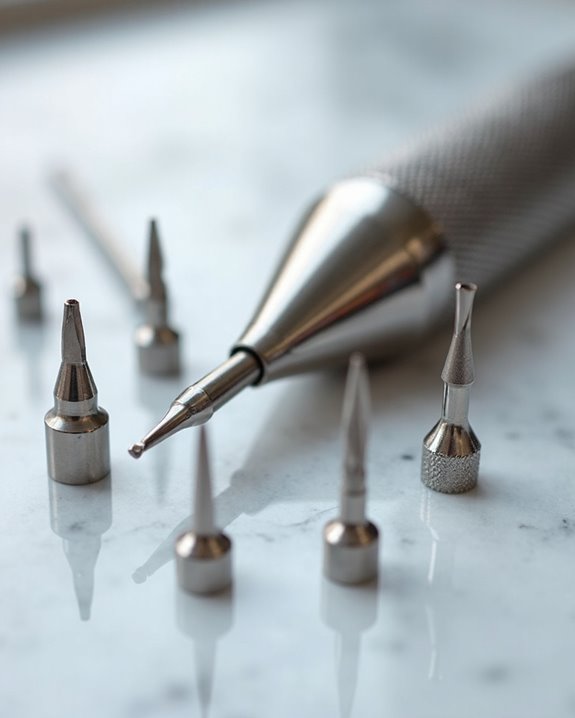
Professional nail technicians must select appropriate drill bits when removing acrylic or gel enhancements, as the correct bit greatly impacts both efficiency and nail health. Carbide bits offer exceptional durability for acrylic removal, withstanding repeated use on tough materials without frequent replacement. For gel removal, mandrel bits paired with sanding bands in various grits provide controlled abrasion while protecting natural nails. Ceramic bits, with their heat-reducing properties, serve as versatile options for both enhancement types, efficiently shaving products while minimizing nail bed overheating risks.
Diamond and cone-shaped drill bits serve specialized functions in the removal process. Diamond bits excel at scratching away residue without deep cutting, while tapered cone bits access difficult areas like sidewalls and under the nail edge, making them essential for thorough product extraction in tight spaces. Additionally, tungsten carbide bits are ideal for maintaining sharpness during acrylic removal, allowing for precise and long-lasting performance in home or professional settings.
Cuticle Preparation Techniques With Specialized Bits

Proper cuticle preparation serves as the foundation for long-lasting, professional nail enhancements, requiring specialized drill bits designed specifically for this delicate area. Safety Carbide Bit options, particularly those with Ball Head or Snake Head Cuticle designs, allow technicians to access the cuticle area without damaging the natural nail plate or surrounding tissue.
The Cuticle Cleaner Carbide bit excels at preparing the cuticle by efficiently removing dead skin and lifting loose debris from the nail plate. Cone-shaped and ball-top bits work effectively around the cuticle area and sidewalls, providing gentle yet thorough cleaning of the Eponychium. Head Cuticle Cleaner bits feature rounded tops specifically engineered to remove loose cuticle material while minimizing heat buildup and client discomfort. These specialized bits guarantee proper adhesion of enhancement products by creating a clean, debris-free surface.
Shaping and Refining Natural Nails With Barrel Bits
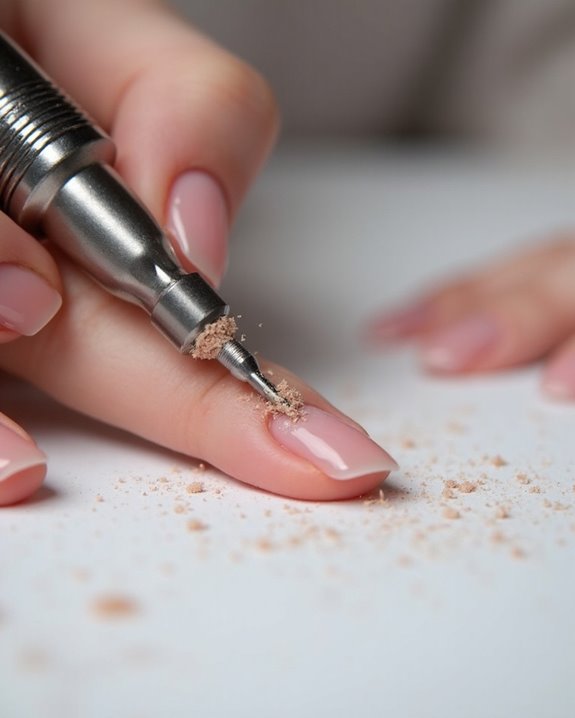
Barrel bits serve as essential tools in nail technology for shaping and refining natural nails, offering technicians precision control during the contouring process. These specialized bits perform surface work on natural nails by smoothing imperfections and creating even edges, making them indispensable for professional manicure and pedicure services. The Top Large Barrel Ceramic bit effectively shortens nails while the Small Barrel shape bit provides detailed refinement during in-fill procedures.
When operating an electric file with barrel bits, technicians must employ side-to-side movements while avoiding the cuticle area without damaging surrounding tissue. This technique guarantees best results while maintaining nail integrity. Tapered barrel bits, featuring a flat top and reduced length, excel at refining natural nails by addressing minor surface irregularities before polish application, thereby establishing a smooth, professional foundation for subsequent treatments.
Callus Removal and Foot Care Applications
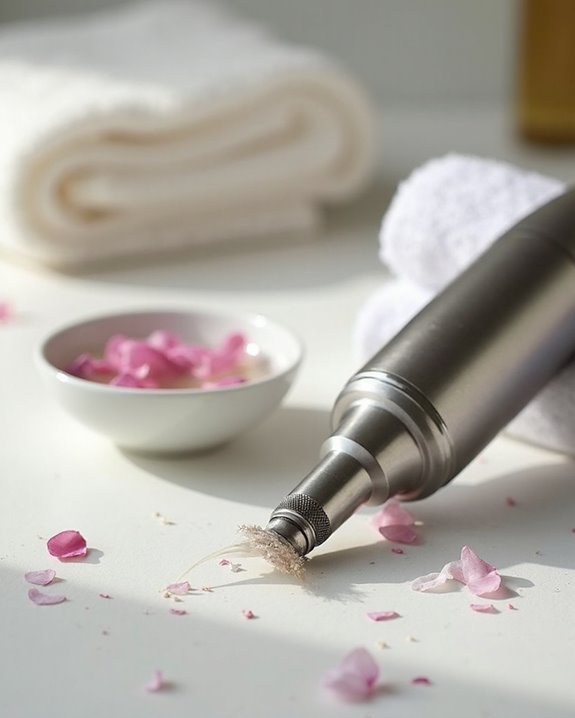
Nail drills equipped with specialized bits serve as essential tools for effective callus removal and thorough foot care during pedicure treatments. When operating at a minimum of 15,000 RPM, electric files with various carbide bits efficiently address hardened skin with less physical effort than manual techniques. Barrel Ceramic Nail Drills excel at buffing and smoothing calluses, effectively addressing the hard skin that commonly develops on feet. Technicians use cone bits to gently shave off products and remove dead cuticle between toes, resulting in smoother skin texture. For more precise work around the eponychium, ball top shaped bits and Large Flame ceramic bits allow professionals to clean up rough areas without damaging surrounding tissue. These specialized tools make pedicure treatments more efficient while enhancing precision and client comfort.
Safety Precautions and Best Practices for Nail Drill Use
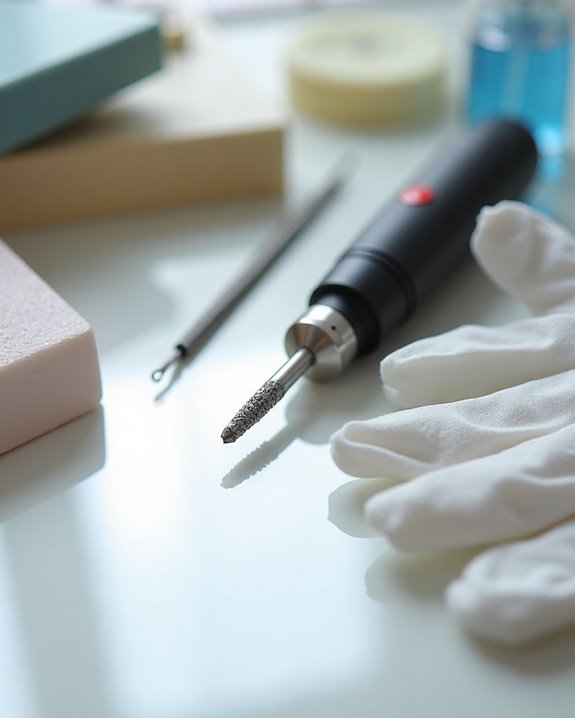
Because electric nail drills operate at high speeds with precision cutting capabilities, adherence to strict safety protocols remains paramount for both technicians and clients alike. Professionals must fit a professional electric file with the right ceramic coated bits designed for specific tasks, particularly using bits with rounded tops for sidewalls without damaging your clients nail. To reduce heat and potential discomfort, technicians should select devices with low vibration and appropriate RPM levels, while always using one sanding band per customer to prevent cross-contamination.
Proper training and certification are essential before operating these tools, as technicians must learn to work along natural nail beds without damaging your clients. Storing Your Nail Drill bits in dry, organized cases after thorough sanitization in ultrasonic cleaners or barbicide solutions guarantees both longevity of equipment and continued client safety.
Time-Saving Techniques for Nail Technicians
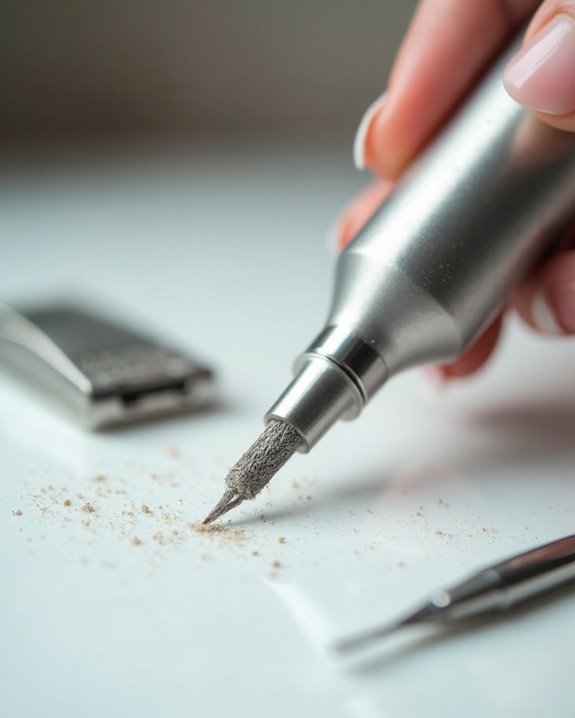
The strategic implementation of electric nail drills revolutionizes efficiency for nail professionals, cutting service times substantially while maintaining quality results. Nail technicians find that electric files operating at 15,000+ RPM help shave off products much faster than manual methods, making the entire process easier and preserving valuable time when working with clients. Tapered drill bits offer precision for side-to-side removal of lifted acrylic, while cone bits quickly clean under nails and sidewalls.
Sanding bands paired with diamond or coarse silicone bits streamline surface smoothing tasks, greatly reducing finishing time. Many professionals invest in carbide bits, which are long lasting and remain effective through multiple sessions without requiring frequent replacement, helping save you some valuable minutes during busy scheduling periods.
Choosing the Right RPM and Torque for Different Services
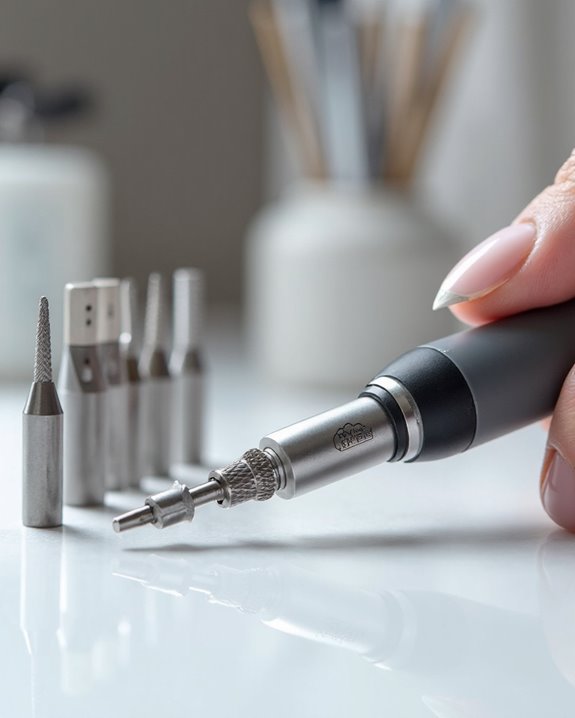
Selecting appropriate speed and power settings represents a critical decision point for nail professionals seeking best results across varied services. This Guide to Nail Drill specifications highlights that for natural nail manicures, electric files should operate at minimum 15,000 RPM to guarantee efficient buffing without damaging delicate nail material. Conversely, acrylic nail services demand tools with 25,000+ RPM capacity, providing necessary power for effective shaping and removal.
When picking just the right nail drill for professional use, torque capabilities merit equal consideration alongside speed. The breakdown of the different tool options should include torque assessment, particularly for demanding tasks like callus reduction in pedicures or acrylic removal. To Choose the Best equipment for different uses and purposes, professionals must match both RPM and torque specifications to their specific service requirements.
Maintenance and Cleaning Protocols for Nail Drill Equipment
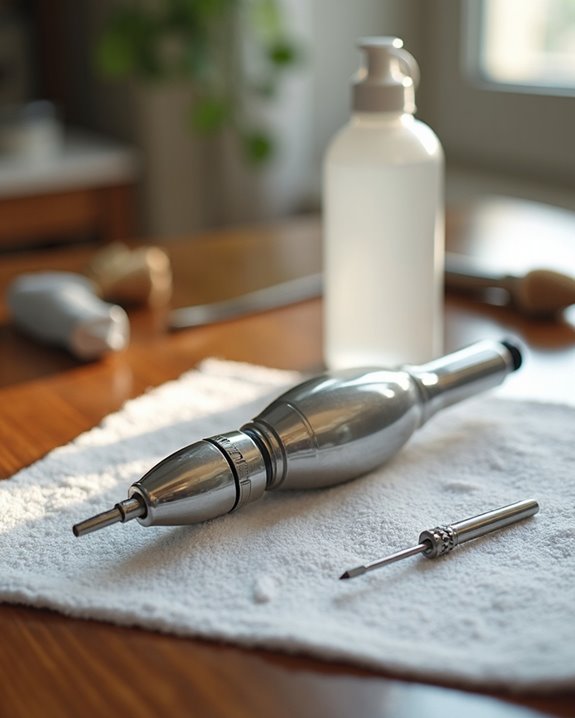
Proper maintenance of nail drill equipment stands as a cornerstone of professional nail services, ensuring both client safety and tool longevity. Materials of Nail Drill bits directly impact cleaning methods, as carbide bits are made to withstand sterilization while ceramic bits are intended for repeated sanitization between clients. Technicians must clean the cuticles of all residue before storing bits in a designated case of nail drill components, which prevents damage and contamination.
Notably, technicians cannot disinfect disposable sanding bands, which come in single-use varieties only. For reusable nail bits, the number of flute cuts actually determines the grit level and cleaning requirements. Following mandatory sterilization protocols after each client prevents cross-contamination, with each bit requiring specific maintenance based on its material composition and intended application.
Frequently Asked Questions
What Is the Purpose of a Nail Drill?
The nail drill’s purpose encompasses professional nail filing, shaping, and buffing. This manicure equipment serves as a removal method for acrylics, speeds enhancement for technicians, and functions as a pedicure aid in both professional and home use.
Why Do Nail Techs Drill Under Nails?
Like gardeners clearing hidden weeds, nail techs drill under nails for thorough debris removal, reducing hygiene risks and infection causes. This technique requires professional training to avoid errors, with aftercare tips minimizing safety concerns for clients.
What Do the Colors on Nail Drill Bits Mean?
Bit markings and color indicators on nail drill bits offer visual coded shades that represent material properties. Gold or silver tint meanings typically identify carbide metal, while other hue symbols may denote different materials or functions.
What Is the White Nail Drill Bit For?
Why struggle with nail residue? The White Bit excels at removing product buildup without damaging natural nails. Proper Speed Adjustment while using this Filing Method guarantees effective Polishing Technique with minimal Application Errors.

